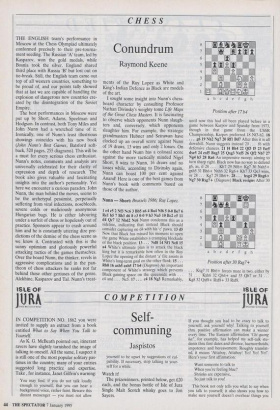CHESS
Conundrum
Raymond Keene
THE ENGLISH team's performance in Moscow at the Chess Olympiad ultimately conformed precisely to their pre-tourna- ment seeding. The Russian 'A' team, led by Kasparov, won the gold medals, while Bosnia took the silver. England shared third place with Russia 'B' but lost out on tie-break. Still, the English team came out top of all western countries, something to be proud of, and our points tally showed that at last we are capable of handling the explosion of dangerous new countries cre- ated by the disintegration of the Soviet Empire.
The best performances in Moscow were put up by Short, Adams, Speelman and Hodgson. In contrast, both Tony Miles and John Nunn had a wretched time of it. Ironically, one of Nunn's least illustrious showings coincides with his new book (John Nunn's Best Games, Batsford soft- back, 320 pages, 255 diagrams). This will be a must for every serious chess enthusiast. Nunn's notes, comments and analysis are universally celebrated for their clarity of expression and depth of research. The book also gives valuable and fascinating insights into the author's personality. Yet here we encounter a curious paradox. John Nunn, the man behind the moves, seems to be the archetypal pessimist, perpetually suffering from viral infections, nosebleeds, severe colds or maliciously anonymous Hungarian bugs. He is either labouring under a surfeit of chess or hopelessly out of practice. Sponsors appear to crash around him and he is constantly uttering dire pre- dictions of the demise of the chess scene as we know it. Contrasted with this is the sunny optimism and gloriously powerful attacking tactics of the games themselves. Over the board Nunn, the thinker, revels in aggressive complications and in the pan- theon of chess attackers he ranks not far behind those other geniuses of the genre, Alekhine, Kasparov and Tal. Nunn's treat- ments of the Ruy Lopez as White and King's Indian Defence as Black are models of the art.
I sought some insight into Nunn's chess- board character by consulting Professor Nathan Divinsky's weighty tome Life Maps of the Great Chess Masters. It is fascinating to observe which opponents Nunn slaugh- ters and, conversely, which opponents slaughter him. For example, the strategic grandmasters Hubner and Seirawan have clocked up an overall score against Nunn of 19 draws, 13 wins and only 2 losses. On the other hand Nunn has a colossal score against the more tactically minded Nigel Short, 8 wins to Nunn, 16 draws and no losses while, according to Divinsky again, Nunn can boast 100 per cent against Anand! Here is one of the best games from Nunn's book with comments based on those of the author.
Nuno — Short: Brussels 1986; Ruy Lopez.
1 e4 e5 2 Nf3 Nc6 3 Bb5 a6 4 Ba4 Nf6 5 0-0 Bel 6 Rel b5 7 Bb3 d6 8 c3 0-0 9 b3 Na5 10 Bc2 c5 11 d4 Qc7 12 Nbd2 Nc6 Nunn condemns this as a sideline, indicating that instead Black should consider capturing on d4 with his 'c' pawn. 13 d5 Now that Black has missed his moment to open the game White establishes a cramping blockade of the black position. 13 ... Nd8 14 Nfl Ne8 15 a4 White's ultimate plan is to attack the black king but it is remarkable how often in the Ruy Lopez the opening of the distant 'a' file assists in White's long-term goal on the other flank. 15 ... Rb8 16 axb5 axb5 17 b4 (Diagram) An important component of White's strategy which prevents Black gaining space on the queenside with . . . c4 and . . . Nc5. 17 ... c4 18 Ng3 Remarkably, Position after 17 b4
until now this had all been played before in a game between Karpov and Spassky from 1973, though in that game from the USSR Championship, Karpov preferred 18 Nf3-h2. 18
g6 19 Nh2 Ng7 20 Rfl Bd7 After this it is all downhill. Nunn suggests instead 20 . . . f6 with defensive chances. 21 f4 Bh4 22 Qf3 f5 23 fxe5 dxe5 24 exf5 Bxg3 25 Qxg3 NxfS 26 Qf2 Nb7 27 Ng4 h5 28 Ra6 An impressive swoop, aiming to turn sharp right. Black now has no way to defend g6, as, if 28 . . . Kh7 29 Nf6+ Kg7 30 Nxh5 + 015 31 Bh6+ Nxh6 32 Rg6+ Kh7 33 Qe3 wins, or 28 . . . Kg7 29 Bh6+. 28 . hxg4 29 Rxg6+ Ng7 30 Rxg7+ (Diagram) Black resigns After 30 Position after 30 Rxg7+ . . . Kxg7 31 Bh6+ forces mate in two, either by 31 .. . Kati6 32 Qh4+ and 33 Qh7 or 31 .. . Kg8 32 Qxf8+ Rxf8+ 33 RxfS.


















































 Previous page
Previous page